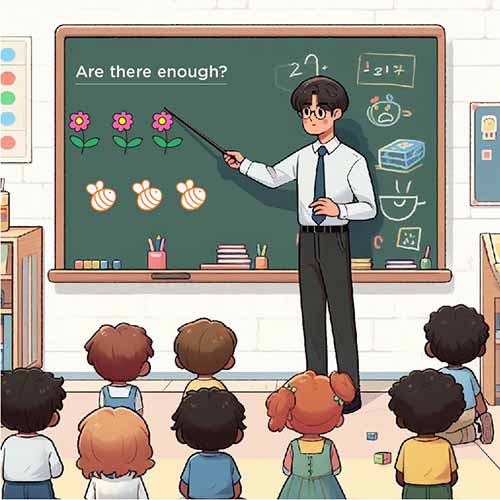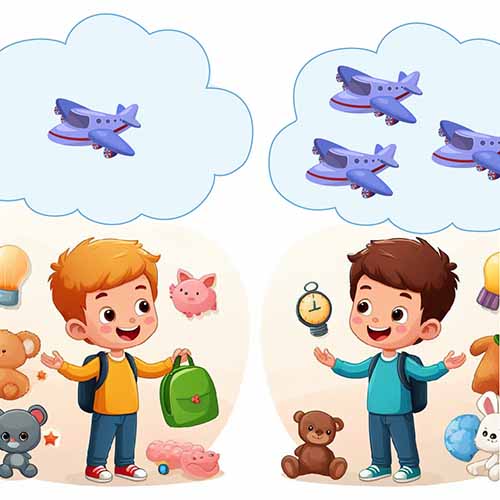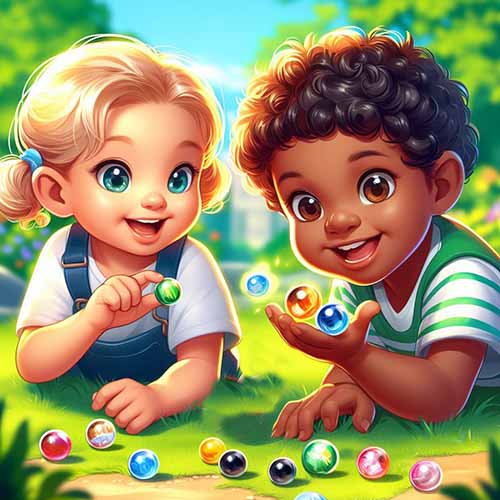Comparing Lesson Plans for Pre-K & Kindergarten Teachers with MathSkills4Kids Videos
-

Classroom comparing lesson - By BING -
Teaching comparing to pre-k students can be a fun and rewarding experience, but also a challenging one. How do you help young learners understand the concepts and vocabulary of comparing quantities, needs, attributes, groups, and numbers? How do you make the lessons engaging, interactive, and meaningful? How do you use math videos to support your instruction and assessment?
This page will share some of the best lesson plans for teaching comparing to Pre-K and Kindergarten students using MathSkills4Kids videos.
These videos are designed to help students learn math skills in a fun and easy way, with colorful animations, catchy songs, and clear explanations. You can use these videos to introduce, practice, or review the topics of comparing in your classroom.
We will also provide web and YouTube video links for more examples and resources on teaching comparing to pre-k and kindergarten students. You will find some tips and tricks on effectively using these videos in your instruction.
The Benefits and Challenges of Teaching Comparing to Pre-K and Kindergarten Students
Comparing is one of the foundational math skills that pre-k and kindergarten students need to develop. Comparing helps students understand the relationships between quantities, needs, attributes, groups, and numbers. Comparing also helps students develop critical thinking, problem-solving, and communication skills.
However, teaching comparing to kids can also be challenging. They have different levels of readiness, interest, and prior knowledge. They may have difficulty understanding abstract concepts or using formal language. They may also have short attention spans or get easily distracted.
Therefore, using effective strategies and tools to teach comparing to pre-k and kindergarten students is essential. One of the best tools you can use is MathSkills4Kids videos. These videos are designed to help students learn math skills in a fun and easy way. They use colorful animations, catchy songs, and clear explanations to capture students' attention and curiosity. They also use concrete examples, visual aids, and repetition to reinforce students' understanding and memory.
-
COMPARING
-
BROWSE THE LESSON PLANS
-
-
More or Less? The Concepts and Vocabulary of Comparing Quantities
Comparing quantities is one of the first mathematical concepts pre-K and Kindergarten students encounter. Comparing is the ability to determine whether two or more objects or groups have the same amount or whether one has more or less than another. Comparing helps students develop number sense, measurement skills, and logical thinking.
To teach comparing to pre-K and Kindergarten students, teachers need to introduce the concepts and vocabulary of comparing quantities in a concrete and meaningful way. Some of the keywords and phrases that students need to learn are:
- More: Having a greater amount or number of something than another object or group.
For example, "There are more apples than oranges in the basket." - Less: Having a smaller amount or number of something than another object or group.
For example, "There are less pencils than crayons in the box." - Same: Having an equal amount or number of something as another object or group.
For example, "There are the same number of boys and girls in the class." - Different: Having an unequal amount or number of something as another object or group.
For example, "The cups have different amounts of water in them."
Teachers can use these keywords to help pre-K and Kindergarten students develop the concepts and vocabulary of comparing quantities fun and engagingly.
READ FURTHER
-
Enough or Not Enough? The Applications and Implications of Comparing Needs
One of the most important reasons to teach comparing to pre-K and Kindergarten students is to help them develop a sense of empathy and social responsibility. Comparing needs is a way of understanding how different people have different situations and challenges and how we can help each other by sharing and caring. Comparing needs also helps students learn about the fundamental human rights and values everyone deserves, such as food, water, shelter, health, education, and safety.
Some of the activities that you can use to teach comparing needs are:
- Playing games or doing experiments that involve comparing the amount of water, food, or other items that different people need or use in a day, a week, or a month. You can ask students to estimate, measure, record their findings, and compare them with the average or recommended amounts for different age groups or regions.
- Creating posters or collages illustrating people's different needs and how they can be met or fulfilled. You can ask students to use pictures, words, symbols, or drawings to represent their needs and to label them with the appropriate vocabulary words. You can also ask students to compare their posters or collages with each other and identify similarities and differences.
-
Larger or Smaller? The Skills and Strategies of Comparing Attributes
Another aspect of comparing that pre-K students need to learn is how to compare the attributes of objects, such as size, shape, color, weight, texture, etc. Comparing attributes helps students develop their spatial reasoning and measurement skills and their ability to classify and sort objects based on different criteria. Comparing attributes also helps students enhance their vocabulary and communication skills as they learn to use descriptive words and phrases to express their observations and opinions.
Some of the activities that you can use to teach comparing attributes are:
- Using manipulatives or toys with different attributes, such as blocks, beads, balls, dolls, cars, etc. You can ask students to compare two or more objects based on one or more attributes, such as which one is larger or smaller, heavier or lighter, longer or shorter, etc. You can also ask students to arrange the objects in order from smallest to largest, lightest to heaviest, shortest to longest, etc.
- Using pictures or drawings that show objects with different attributes, such as animals, plants, fruits, vehicles, etc. You can ask students to compare two or more pictures based on one or more attributes, such as which one has more or fewer legs, leaves, seeds, wheels, etc. You can also ask students to match the pictures with the corresponding words or labels that describe their attributes.
- Using real-life objects or situations that involve comparing attributes, such as clothes, shoes, books, containers, etc. You can ask students to compare their own clothes or shoes with those of their classmates or teachers based on size, color, style, etc.
You can also ask students to compare the amounts of liquid or solid different containers can hold or the number of pages or words different books have.
-
Fewer or More? The Connections and Extensions of Comparing Groups
One of the most important skills pre-K and Kindergarten students need to develop is the ability to compare groups of objects and identify which group has fewer or more. This skill helps them to understand the concept of quantity, which is essential for learning mathematics. Comparing groups also helps them to develop their logical thinking, problem-solving, and communication skills.
There are many ways to teach comparing groups to pre-K students, but one of the most influential and engaging methods is using MathSkills4Kids videos. These videos are designed to help young learners master various math topics through fun and interactive activities. In this article, we will show you how MathSkills4Kids videos can help you teach comparing groups to your students and how you can use them to enhance your lesson plans.
-
How to Use MathSkills4Kids Videos to Enhance Your Lesson Plans
MathSkills4Kids videos can be used as a supplement or a complement to your existing lesson plans on comparing groups. Here are some suggestions on how you can use them in your classroom:
- Before the lesson: You can use MathSkills4Kids videos as a warm-up activity to introduce the topic of comparing groups and activate your students' prior knowledge. You can also use them as a pre-assessment tool to gauge the level of understanding and readiness of your pre-K students.
- During the lesson: You can use MathSkills4Kids videos as a teaching tool to explain the concepts and vocabulary of comparing groups and demonstrate the skills and strategies of comparing groups. You can also use them as a practice tool to provide your pre-K students with opportunities to apply what they have learned and check their understanding.
- After the lesson: You can use MathSkills4Kids videos as a review tool to reinforce the learning outcomes and consolidate your students' learning. You can also use them as an extension tool to challenge your students with higher-order thinking questions and tasks.
- More: Having a greater amount or number of something than another object or group.
Conclusion: The Best Practices for Teaching Comparing with MathSkills4Kids Videos
Comparing groups is a crucial skill pre-K students must master for mathematical development. MathSkills4Kids videos can help you effectively and efficiently teach this skill by providing high-quality, engaging resources supporting your lesson plans. Here are some best practices for teaching comparing with MathSkills4Kids videos:
- Choose the appropriate videos that match your lesson plans' learning objectives and standards.
- Preview the videos before using them in your classroom, and prepare any necessary materials or equipment.
- Introduce the videos to your students and explain the purpose and expectations of watching them.
- Monitor and guide your students as they watch the videos and interact with them during or after them.
- Assess and evaluate your students' learning outcomes and progress using formative or summative methods.
We hope this article has given you some valuable tips on how to use MathSkills4Kids videos to teach comparing groups to your pre-K or Kindergarten students. If you want to access more MathSkills4Kids videos, visit MathSkills4Kids YouTube channel.
Please CLICK THE SHARE BUTTON to allow others to benefit from this content!
Happy teaching!






